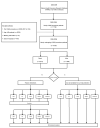Machine-Learning Techniques for Feature Selection and Prediction of Mortality in Elderly CABG Patients
- PMID: 34067148
- PMCID: PMC8151160
- DOI: 10.3390/healthcare9050547
Machine-Learning Techniques for Feature Selection and Prediction of Mortality in Elderly CABG Patients
Abstract
Coronary artery bypass surgery grafting (CABG) is a commonly efficient treatment for coronary artery disease patients. Even if we know the underlying disease, and advancing age is related to survival, there is no research using the one year before surgery and operation-associated factors as predicting elements. This research used different machine-learning methods to select the features and predict older adults' survival (more than 65 years old). This nationwide population-based cohort study used the National Health Insurance Research Database (NHIRD), the largest and most complete dataset in Taiwan. We extracted the data of older patients who had received their first CABG surgery criteria between January 2008 and December 2009 (n = 3728), and we used five different machine-learning methods to select the features and predict survival rates. The results show that, without variable selection, XGBoost had the best predictive ability. Upon selecting XGBoost and adding the CHA2DS score, acute pancreatitis, and acute kidney failure for further predictive analysis, MARS had the best prediction performance, and it only needed 10 variables. This study's advantages are that it is innovative and useful for clinical decision making, and machine learning could achieve better prediction with fewer variables. If we could predict patients' survival risk before a CABG operation, early prevention and disease management would be possible.
Keywords: CABG; NHIRD; National Health Insurance Research Database; feature selection; machine learning; older adults; overall survival prediction.
Conflict of interest statement
The authors declare no conflict of interest.
Figures
Similar articles
-
The Prediction Model of Medical Expenditure Appling Machine Learning Algorithm in CABG Patients.Healthcare (Basel). 2021 Jun 10;9(6):710. doi: 10.3390/healthcare9060710. Healthcare (Basel). 2021. PMID: 34200785 Free PMC article.
-
Machine learning algorithms for predicting mortality after coronary artery bypass grafting.Front Cardiovasc Med. 2022 Aug 24;9:977747. doi: 10.3389/fcvm.2022.977747. eCollection 2022. Front Cardiovasc Med. 2022. PMID: 36093147 Free PMC article.
-
Comparison of Machine Learning Methods With National Cardiovascular Data Registry Models for Prediction of Risk of Bleeding After Percutaneous Coronary Intervention.JAMA Netw Open. 2019 Jul 3;2(7):e196835. doi: 10.1001/jamanetworkopen.2019.6835. JAMA Netw Open. 2019. PMID: 31290991 Free PMC article.
-
Machine learning in predicting graft failure following kidney transplantation: A systematic review of published predictive models.Int J Med Inform. 2019 Oct;130:103957. doi: 10.1016/j.ijmedinf.2019.103957. Epub 2019 Aug 24. Int J Med Inform. 2019. PMID: 31472443
-
Effect of increasing age on percutaneous coronary intervention vs coronary artery bypass grafting in older adults with unprotected left main coronary artery disease: A meta-analysis and meta-regression.Clin Cardiol. 2019 Nov;42(11):1071-1078. doi: 10.1002/clc.23253. Epub 2019 Sep 5. Clin Cardiol. 2019. PMID: 31486094 Free PMC article. Review.
Cited by
-
Evaluation of machine learning algorithms for the prognosis of breast cancer from the Surveillance, Epidemiology, and End Results database.PLoS One. 2023 Jan 26;18(1):e0280340. doi: 10.1371/journal.pone.0280340. eCollection 2023. PLoS One. 2023. PMID: 36701415 Free PMC article.
-
Comparison of Different Machine Learning Classifiers for Glaucoma Diagnosis Based on Spectralis OCT.Diagnostics (Basel). 2021 Sep 19;11(9):1718. doi: 10.3390/diagnostics11091718. Diagnostics (Basel). 2021. PMID: 34574059 Free PMC article.
-
Machine learning-driven prediction of medical expenses in triple-vessel PCI patients using feature selection.BMC Health Serv Res. 2025 Jan 20;25(1):105. doi: 10.1186/s12913-025-12218-6. BMC Health Serv Res. 2025. PMID: 39833782 Free PMC article.
-
Impact of Pre-Transplant Parathyroidectomy on Graft Survival: A Comparative Study of Renal Transplant Patients (2005-2015).Med Sci Monit. 2023 Aug 1;29:e940959. doi: 10.12659/MSM.940959. Med Sci Monit. 2023. PMID: 37525452 Free PMC article.
-
Machine learning-based hybrid risk estimation system (ERES) in cardiac surgery: Supplementary insights from the ASA score analysis.PLOS Digit Health. 2025 Jun 23;4(6):e0000889. doi: 10.1371/journal.pdig.0000889. eCollection 2025 Jun. PLOS Digit Health. 2025. PMID: 40549810 Free PMC article.
References
-
- Lee T.-S., Li S.-J., Jiang Y., Shia B.-C., Chen M. Cost Analysis of Coronary Artery Bypass Grafting Surgery under Single-Payer Reimbursement in Taiwan. Int. J. Appl. Sci. Eng. 2020;17:419–428. doi: 10.6703/IJASE.202012_17(4).419. - DOI
-
- Chen S.-W., Chang C.-H., Lin Y.-S., Wu V.C.-C., Chen D.-Y., Tsai F.-C., Hung M.-J., Chu P.-H., Lin P.-J., Chen T.-H. Effect of Dialysis Dependence and Duration on Post-Coronary Artery Bypass Grafting Outcomes in Patients with Chronic Kidney Disease: A Nationwide Cohort Study in Asia. Int. J. Cardiol. 2016;223:65–71. doi: 10.1016/j.ijcard.2016.08.121. - DOI - PubMed
LinkOut - more resources
Full Text Sources
Miscellaneous


